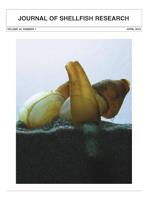In this study, Kimura's likelihood ratio test was used to compare growth curves for Panopea generosa, Panopea globosa, Panopea zelandica, and Panopea abbreviata. The curves were generated from previous studies using the von Bertalanffy growth model (VBGM). Geoducks P. generosa and P. globosa are distributed throughout the northern hemisphere; the other two species are found in the southern hemisphere. Individual parameters were used from the VBGM for each species from previously published resources to calculate the average length-at-age (Lti) data for intervals of 1–20 y. In this study, any Lti estimated for any of the species was considered as data to fit a global model and to compute error estimation. The average asymptotic lengths were 147.5 mm, 142.7 mm, 111.1 mm, and 102.5 mm, respectively, for each species listed earlier. These findings provided good evidence that the northern hemisphere species, P. generosa and P. globosa, are the largest and had no significant differences in length between them. The species from the southern hemisphere (P. zelandica and P. abbreviata) were the shortest, with a significant difference in length between them. Three of the four species analyzed inhabit the Pacific Ocean, with only P. abbreviata, the smallest of the four geoducks studied, being endemic to the southwestern Atlantic.
How to translate text using browser tools
1 March 2015
Comparison of Growth Curves of Four Panopea Species
Eugenio Alberto Aragón-Noriega,
Guillermo Rodríguez-Domínguez
ACCESS THE FULL ARTICLE

Journal of Shellfish Research
Vol. 34 • No. 1
March 2015
Vol. 34 • No. 1
March 2015
geoduck
growth curves
likelihood ratio test
Panopea
von Bertalanffy




